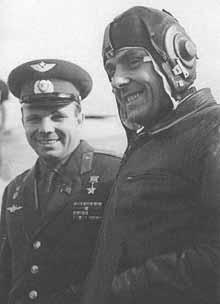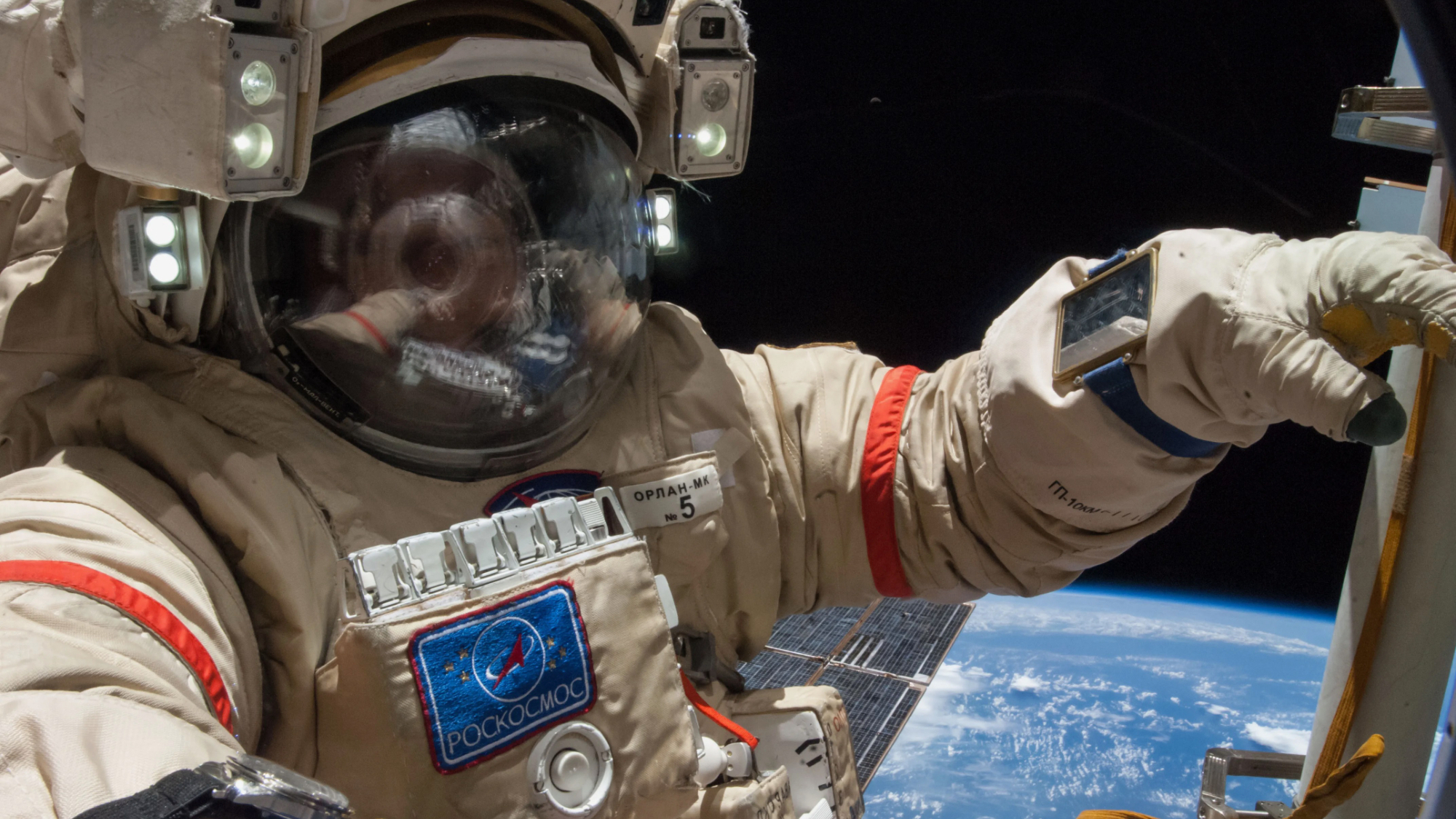New Account of a Russian Cosmonaut's Death Rife with Errors

In the new edition of a book called "Starman" (Bloomsbury 2011) Jamie Doran and Piers Bizony tell the story of the first space fatality — the tragic death of Russian cosmonaut Vladimir Komarov in 1967. The book doesn't hit stores until April 12, but NPR's Robert Krulwich got an advance copy, and covered its heart-wrenching account of the accident in a blog post two weeks ago. Unfortunately, in so doing, he may have publicized an inaccurate rewriting of history.
It was the height of the space race, Krulwich wrote, and the 50th anniversary of the Communist Revolution was approaching. The Soviet Union was eager to pull off a two-spacecraft rendezvous in low-Earth orbit just in time for the big event. The plan was for Komarov to park the Soyuz 1 space capsule next to another vehicle and then spacewalk between them.
That much is true, but historians say the rest of the story printed in "Starman" and recounted on Krulwich's blog is grossly inaccurate. Krulwich told Life's Little Mysteries, a sister site to SPACE.com, that he has come to believe there are errors in the tale he told, but he urges readers to consider the informal nature of blogs — even those labeled "NPR."
Death of a cosmonaut
According to "Starman," Krulwich wrote, Komarov's Soyuz 1 was riddled with problems, and many within the Soviet space program knew it long before take-off. Yuri Gagarin, a national hero for having been the first man in space, supposedly sent a memo to a KGB officer named Venyamin Russayev telling him the rendezvous mission needed to be postponed. The memo was hushed up, though, and everyone who read it, along with Russayev, got demoted, fired or sent to Siberia.
The book's authors assert that Komarov knew he would die if the mission went forth, but he refused to back out of it. The backup pilot, Gagarin, was his beloved friend. Prior to the mission leaving the ground, Komarov supposedly told Russayev the KGB officer that he would take the fall to save Gagarin's life.
Despite Gagarin's last minute attempt to take Komarov's place (Doran and Bizony write that Gagarin showed up before launch demanding to be put in a spacesuit), the mission went forward as planned, with Komarov at the helm of the Soyuz 1 capsule. Right from the start a series of mechanical failures ensued, and soon it was clear that Komarov was doomed.
Breaking space news, the latest updates on rocket launches, skywatching events and more!
According to the book, then Soviet premier Alexei Kosygin even called Komarov and, sobbing, told him he was a hero. As the shoddy space capsule shot down through the atmosphere and crashed into Earth, Doran and Bizony claim that Komarov could be heard "crying in rage," and accusing his superiors of killing him, Krulwich wrote.
Krulwich posted a picture on his blog of Komarov's burnt and shriveled remains.
Web sensation
Not unexpectedly, the blog post got a huge amount of attention – unfortunately so, because, according to Soviet space program historians, the account given in Doran and Bizony's book is rife with inaccuracies.
According to Krulwich, three prominent space historians, including Asif Siddiqi at Fordham University, immediately contacted him questioning the validity of what he had written. He wrote a follow-up post asking everyone not to shoot the messenger, and shifting the blame for any errors to the authors of "Starman." But that reasoning isn't good enough coming from a trusted journalist like Krulwich, some historians now say.
In most historians' views, the main point of contention is the fact that the only source for all the new claims in "Starman" is the former KGB officer, Venyamin Russayev, and no one knows who he actually is.
"All the new information comes from this new previously unknown KGB former agent and 'friend' of Gagarin, and has not been verified by anyone yet. Part of the problem is we don't know how reliable of a source this person is," said space historian Robert Pearlman, editor of the space history and artifacts website collectSPACE. "No one has heard of him until now, and while that in itself shouldn't automatically rule him out as a source for historians, it does require the authors to verify his history and share that with readers."
In the aftermath of his original post, Krulwich has begun checking the facts. When reached for comment, Krulwich told Life's Little Mysteries that the book authors may not have even interviewed Russayev directly.
"They may not even have talked to Russayev. I found some quotes in an Italian newspaper story written by him, and they may have pulled from those," Krulwich said. "It seems to me they should have talked to him."
If the authors had taken the time to verify Russayev's narrative, things would have gotten messy: "His account contradicts information that has long been researched and verified as the accepted truth of what occurred," Pearlman said. [Disclosure: Robert Pearlman is an occasional contributor to SPACE.com.]
The book's account contradicts incontrovertible evidence in the form of air-to-ground transmissions and transcripts from the mission. The Soviet premier did not call the cosmonaut crying, for example. "A conversation between Kosygin and Komarov never occurred," Pearlman said.
"As for the thing about Yuri Gagarin showing up at the launch demanding to be put in a spacesuit, well, they didn't wear spacesuits in the Soyuz capsules," Pearlman said. "Komarov didn't wear a spacesuit." Russian cosmonauts didn't begin wearing spacesuits during launch and landing until 1971, after the three-man crew of Soyuz 11 was killed during an unexpected depressurization of their Soyuz 11 spacecraft during re-entry.
Krulwich said that this error also originated in the book itself, rather than in his retelling.
Other embellishments
Another alleged embellishment is the description of Komarov at death's door, crying with rage and screaming out against his government.
"I simply don't see that as being believable," Pearlman said. "We have the transcripts from the flight, and that hasn't been reported to date. Komarov was an experienced cosmonaut with training as a tech pilot and air force officer. He was trained to deal with high-pressure environments. The idea that he would have lost it is just distasteful. It doesn't fit the impression of the individual as we know it."
Krulwich may just have been passing along information he came across in a book, but in Pearlman's opinion, he should have double-checked the story before posting it on his NPR blog. "With the Internet, stories don't die. Even if historians denounce this as being false, there's always someone out there who says, well, that's a cover up or conspiracy," Pearlman said. "Because of the NPR piece, the story will become forever part of the narrative that surrounds the unfortunate death of Vladimir Komarov."
Krulwich disagrees. He believes those he has upset are confused about the nature of blogging.
"A lot of people in Moscow got a bounce on this and got mad at me as if this story was something I made up, but what I do on my blog is find something that's provocative or interesting and then share it with others," he said. "It's not an NPR news story. A blog is a blog. I fact checked it as best I could, but I just said, 'Here's a book, I wonder whether it's true, let's talk about this.' I think there might be some confusion about what a blog is, but the audience is going to have to get used to that."
[Ed. note: In the original post, Krulwich questions the contents of the book once, but without raising any critical questions: "This version — if it's true — is beyond shocking."]
Krulwich said that his blog post may help bring the truth about Komarov's death to light.
"This book may be false, but I think it's only fair to say, 'let's find out.' Did the authors fact-check, did they speak to Russayev, did they verify his story?" Krulwich said. "Now we have at least three prominent historians trying to find out."
Pearlman and others would argue that this is a step that Krulwich, a respected journalist, should have taken before publishing his post, or that he should have at least voiced his skepticism more plainly. Blog or not, "the job of a reporter is to verify facts before reporting them," Pearlman said. "And Krulwich knows that."
Krulwich, for his part, plans to report his findings on the truth about Komarov's death in future blog posts.
This article was provided by Life's Little Mysteries, a sister site of SPACE.com. Follow Natalie Wolchover on Twitter @nattyover.
Join our Space Forums to keep talking space on the latest missions, night sky and more! And if you have a news tip, correction or comment, let us know at: community@space.com.

Natalie Wolchover was a staff writer for Live Science and a contributor to Space.com from 2010 to 2012. She is now a senior writer and editor at Quanta Magazine, where she specializes in the physical sciences. Her writing has appeared in publications including Popular Science and Nature and has been included in The Best American Science and Nature Writing. She holds a bachelor's degree in physics from Tufts University and has studied physics at the University of California, Berkeley.

